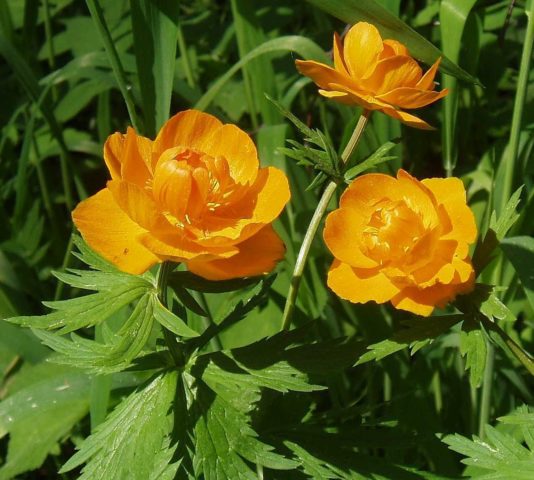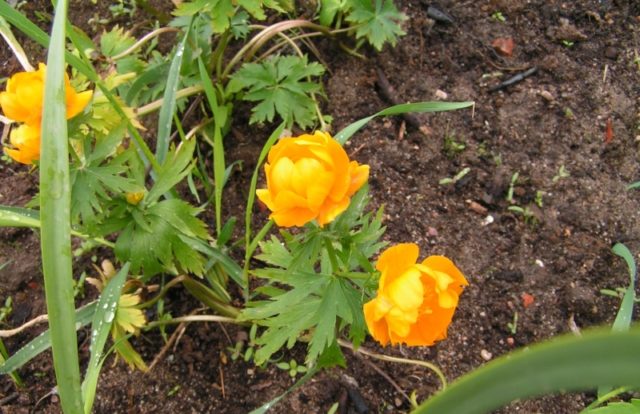Content
The Asian swimmer is an attractive decorative flower. Due to the bright color of the buds, the plant is called “light”. In Siberia the culture is called “zharki” (plural), in Altai it is called “Ogonki-zharki”.
Translated from German, the name “Trollblume” sounds like “troll flower.” According to a beautiful Scandinavian legend, fairy-tale creatures love these flowers most of all - bright, fiery colors. Magic troll-elves, in the light of the June moon, brewed a potion for youth without the use of fire in a spherical golden bowl. To prevent morning dew from getting into the potion, the vessels with the elixir were placed on poles. After sunrise, the mysterious elves poured the drink into bottles, and the empty golden dishes turned into amazingly beautiful bathing flowers.

Modern gardeners with great success use the Asian swimsuit (Trollius) to decorate the local area
Description of an Asian swimsuit
According to the classification, the herbaceous perennial plant Asian swimsuit (lat. Trollius asiaticus L.) belongs to the Buttercup family (Ranunculaceae). It is impossible to take your eyes off the bright yellow colors of the flowers of this decorative crop.
The Asian swimsuit has distinctive features:
- root system - cord-like lobes without a main root;
- stem, smooth, erect, simple or branched;
- stem length from 10 to 80 cm;
- stem leaves are pentagonal, with long petioles, from 1 to 5 pieces on each shoot;
- leaf color is bright green;
- the flowers are large, with 10-20 broadly elliptical petals;
- stamens are short, widened from the base upward and pointed towards the apex;
- flower diameter up to 5 cm;
- the number of buds on each bush is up to 5-10;
- the color of the inflorescences is orange-red;
- flowering - May-June;
- fruits are leaflets, up to 10 mm long with a short, inwardly curved spout.

The plant is pollinated by bees, flies, beetles
Distribution area of the Asian swimmer
In its natural environment, the Asian swimmer lives in Siberia (eastern, western, middle regions), Mongolia and Altai. In the wild, frying birds are found in spacious forest clearings, water meadows, as well as in harsh tundra and mountainous areas at the level of the alpine belt (at an altitude of up to 2800 m).

Colorful frying or Asian swimsuit is the calling card of the Altai Floristic Reserve
Threat of extinction
Currently, the bright and original Asian swimsuit (lights, frying) is barbarically exterminated by humans. The official status of the plant is protected and rare. The culture is listed in the Red Book of the following territorial units:
- The Republic of Sakha (Yakutia);
- The Republic of Buryatia;
- Yamalo-Nenets Autonomous Okrug;
- Khanty-Mansi Autonomous Okrug;
- Omsk region.
Abundant natural stands of asiatica trollius are rapidly disappearing near populated areas as people use the plant for cutting into bouquets.

Gardeners love the “Siberian rose” culture for the inimitable resemblance of the buds to the “queen of flowers”
Application in landscape design
The early and bright flowering of the Asian swimmer (Trollius) “plays into the hands” of landscape designers. Along with the colorful colors of tulips, daffodils, irises, peonies, fiery spots of decorative culture will look very original.
On rocky soils, the plant thrives next to sedum, sedum and other ground cover crops.
Additionally, Asian stir-fries pair well with flowering perennials:
- lilac;
- magnolia;
- spirea;
- bells;
- host;
- bergenia.

Lushly flowering frying bushes will very beautifully complement the storyline of the shore of a small body of water
Reproduction methods
The Siberian Asian swimmer reproduces in several ways:
- seminal;
- vegetative (cuttings, dividing the bush).
It should be remembered that when propagated by seed, an ornamental crop can produce flower stalks only after several years. The vegetative method allows you to enjoy the bright fiery flowers of the Asian fire the very next year.

Bush division is the most commonly used frying propagation method.
Seed method
The seed method of propagating ornamental crops does not involve complex agricultural technology. Ripe or purchased seed material of the Asian swimmer (Trollius) is sown in open ground in August-October (depending on the climate).
The seeds of the Asian Siberian swimmer are distributed over the surface of the soil, sprinkled with a mixture of leaf soil, river sand and peat.
During the winter, the seeds become stratified naturally. The first shoots appear only at the end of May.
For seedlings of the Asian Siberian swimmer, moderate watering and mandatory shading from scorching sun rays are recommended.
After the appearance of the first pair of leaves, young seedlings of the Asian swimsuit are plucked or simply thinned out.

Siberian lights, propagated by seed, bloom only after 2-3 years of life
Cuttings
Cuttings are a fairly successful method of propagating the Siberian Asian swimmer. After flowering ends, strong and healthy shoots located at the base of the bush are cut off. Cuttings of Asian swimmer (Trollius) can be treated with a root growth stimulator. Prepared shoots are placed for rooting in a mixture of sand, perlite and peat.

After final rooting, young frying bushes can be moved to a permanent place
Dividing the bush
Dividing the bush is the simplest and most accessible method for every gardener to propagate the Asian swimmer (Trollius). The procedure is carried out in autumn or spring.
The mother bush of the Asian Siberian swimmer is completely removed from the ground, the root system is shaken off and washed.
Using garden tools, the roots and shoots are divided into several parts so that each plot has 3-4 viable buds.
The cut areas are treated with wood ash.
It is recommended to plant the plots of the Asian swimsuit (Trollius) in open ground on the same day, deepening the root collar by 2-3 cm.

Adult frying bushes (from 5 years of age) are suitable for propagation by division.
Planting and care
The Asian swimsuit flower is an unpretentious ornamental crop that successfully grows and develops in the wild without human intervention. On a personal plot, the plant should be provided with minimal care:
- watering;
- loosening the soil;
- weed removal;
- feeding;
- pest elimination;
- fight against diseases.
Site selection and preparation
When choosing a planting site for the Asian swimsuit (Trollius), you should proceed from the following requirements:
- a sufficient amount of sunlight or slight partial shade from trees and architectural forms;
- well-drained, loose, fertile, preferably acidic soil with plenty of humus.

The ideal soil mixture for the growth of frying is considered to be a mixture of leaf soil, peat, sand
Landing algorithm
The best time to plant Siberian Asian swimsuit is early spring or mid-autumn. The optimal distance between planting holes is up to 40 cm. The dimensions of the holes must correspond to the size of seedlings, plots or rooted cuttings.
How to transplant Asian lights to their permanent “place of residence”:
- In the case of growing seedlings of Asian swimsuit from seeds, the seedlings are carefully removed along with a lump of earth and planted in a new place.
- When transplanting cuttings of the bathing suit, young plants are also moved to the garden bed without shaking or washing off the soil from the roots.
- Plots of Asian swimmer, obtained by dividing the bush, should be replanted on the day of distribution of the root system of the mother plant to prevent drying.

Experienced gardeners and flower growers recommend replanting Siberian lights to a new location every 5-7 years
Watering and fertilizing schedule
Decorative frying is a fairly moisture-loving crop. Regular watering is the key to active flowering in May-June. During dry summers, the bushes of the Asian Siberian swimmer require especially active watering.
Feeding is carried out in several stages:
- in early spring - adding humus and peat;
- before flowering - fertilize with Nitrophoska, Agricola;
- during flowering, when watering, add a urea solution;
- in early autumn - fertilize with humus and peat.

Simultaneously with watering, it is recommended to weed weeds and loosen the soil to prevent water stagnation
Preparing for winter
The Asian swimsuit is a real Siberian. The decorative crop is characterized by stable frost resistance. Frying does not require winter shelter.

In October, dry leaves and shoots should be cut to a height of up to 3 cm from the ground level
Diseases and pests
Garden frying is characterized by stable immunity to pathogens of various fungal, bacterial and infectious diseases. In rare cases, Asian swimmer bushes can attack:
- Septoria - a fungal disease that is manifested by the presence of light spots with a dark border on the leaf blades.
Modern fungicides should be used to combat septoria on plants.
- Smut, it appears as dark spots (fungal spores) on the above-ground parts of the ornamental crop.
Smut disease disrupts metabolism and causes plant death
- Short-bodied nematode - the main pest that parasitizes the root system of the Asian fireweed.
Treatment with insecticides (Nematodos) allows you to get rid of parasites
Beneficial features
The beneficial properties of Asian swimsuit are explained by the unique natural composition of biomass:
- flavonoids;
- phenolcarboxylic acids;
- sapronins;
- carotene;
- choline;
- coumarins;
- valuable vitamins and microelements.
The above-ground parts of the plant (leaves, flowers, seeds) are used for medicinal purposes.

The roots of frying are poisonous, therefore they are used very rarely for medicinal purposes.
Use in folk medicine
Asian swimmer is a famous natural “healer”, which is characterized by a huge number of healing properties:
- restoration of vision;
- treatment of menstrual disorders;
- treatment of digestive disorders;
- treatment of blood diseases;
- anti-inflammatory;
- antitumor;
- tonic;
- decongestant;
- diuretic;
- anti-scorbutic effect.
Directories of traditional medicine contain many recipes for ointments, infusions, decoctions from leaves, flowers, and seeds of the stems of Asian lights.

Frying is used to treat domestic animals (treating the udder of cows with a decoction of the stems)
Restrictions and contraindications
In some cases, the use of an Asian swimsuit may cause side effects. The most dangerous are considered to be damage to the central nervous system, allergic reactions, and individual intolerance.

In practice, the composition of the swimsuit biomass has not been fully studied, so it should be used with caution for medicinal purposes.
Conclusion
Asian flowerpot is a very beautiful ornamental plant that can add bright colors to any garden. An unpretentious, frost-resistant crop is characterized by stable and very abundant budding for 5-10 years, while requiring minimal care.











